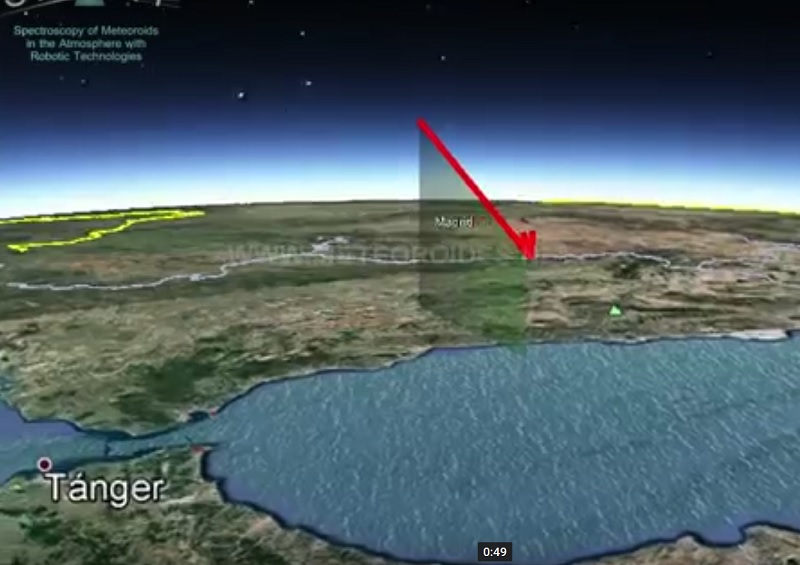Abstract: Three stations of the FRIPON network registered a fireball on 22 January 2021, 06h51m50s UT above Belgium. The trajectory and orbit could be computed. The slow fireball penetrated deep into the atmosphere until an ending height of 27 km at a final velocity of 6 km/s. There is a possibility that a remnant has reached the surface.
1 Introduction
In the early morning of 2021 January 22, a slow-moving fireball appeared above Belgium at 6h51m50s UT, shortly after that most meteor cameras in the BeNeLux had stopped capturing once the Sun passed above 8° under the horizon. Most camera stations suffered bad weather circumstances with a complete overcast sky.
The fireball was seen by many casual eyewitnesses as the time of appearance was when many people were on their way to go to work. The event was immediately discussed on social media with some video recordings and descriptions. Luckily, some cameras of the FRIPON network caught the fireball at Noordwijk, the Netherlands (NLWN01), Oostkapelle, the Netherlands (NLWN02) (Figure 1) and Brussels, Belgium (BEBR01, Figure 3). The fireball reached an absolute magnitude of almost –8 (Figure 2).

Figure 1 – The 2021 January 22 fireball at 6h51m50s UT as recorded by the FRIPON camera at Oostkapelle, the Netherlands (credit FRIPON).

Figure 2 – The 2021 January 22 fireball at 6h51m50s UT luminosity profile (credit FRIPON).

Figure 3 – The FRIPON camera on the roof of the BISA institute in Uccle, Belgium (credit Hervé Lamy).
2 The fireball trajectory
The meteor entered the atmosphere above the Belgian-Dutch border, between the cities of Antwerp and Gent, ending above Dendermonde with a rather steep entrance angle with a total duration of about 3.5 seconds (Figure 4). Detected at a height of 70 km, the fireball penetrated deep into the atmosphere with an ending height at 27 km, suggesting that any possible left over may have dropped as a meteorite on the surface (Figure 5). With an initial velocity of 16 km/s this was a very slow event, the deceleration during the decent through the atmosphere resulted in a final velocity of 6 km/s, which is also favorable for the chances of a small remnant to have reached the ground (Figure 6). More computation work by the FRIPON team determined that any possible fragments that survived the transit through the atmosphere may have landed south of Dendermonde and Berlare, north of the city Aalst (Figure 7). Any reports from owners who may discover some suspect meteorite like objects on their property may help if some remnant did reach the surface.

Figure 4 – The 2021 January 22 fireball at 6h51m50s UT the fireball trajectory above Belgium (credit FRIPON).

Figure 5 – The 2021 January 22 fireball at 6h51m50s UT the altitude versus time profile (credit FRIPON).

Figure 6 – The 2021 January 22 fireball at 6h51m50s UT the velocity and deceleration in function of the altitude (credit FRIPON).

Figure 7 – The 2021 January 22 fireball at 6h51m50s UT the strewn field (credit FRIPON).
3 The orbit
The orbit could be calculated and suggests an asteroidal origin (Figure 8). A check-up with the IAU meteor shower list revealed no association to any known meteor shower, hence we can conclude this was a sporadic fireball.
- q = 0.9575 ± 0.0002 AU
- a = 1.28 ± 0.007 AU
- e = 0.2519 ± 0.0038
- i = 20.08 ± 0.09°
- ω = 210.10 ± 0.24°
- Ω = 302.20 ± 0.0004°
- Tj = 4.97

Figure 8 – The 2021 January 22 fireball at 6h51m50s UT the orbit of the fireball (dark line) (credit FRIPON).









Are there more precise calculations for the strewn field, taking the wind and probable meteorite sizes into account? This is very close to my home so I have lots of opportunity to hunt, but some more educated guesses would be welcome 🙂